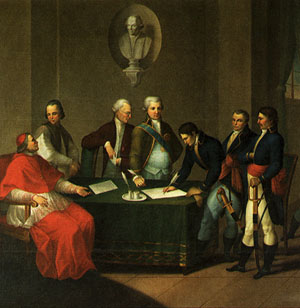The profound action of humanism and the Renaissance among Catholics spread unceasingly throughout France in a growing chain of consequences.

Title page of Augustinus by Jansenist founder Cornelius Otto Jansen. This book published in 1640 formed the basis of Jansenism.
Favored by the weakening of piety in the faithful caused by Jansenism and the other leavens sixteenth-century Protestantism had unfortunately left in the Most Christian Kingdom, this action gave rise in the eighteenth century to a nearly universal dissolution of customs, a frivolous and superficial way of considering things, and a deification of earthly life that paved the way for the gradual victory of irreligion.
Doubts about the Church, the denial of the divinity of Christ, deism, and incipient atheism marked the stages of this apostasy.
The French Revolution was the heir of Renaissance neopaganism and of Protestantism, with which it had a profound affinity. It carried out a work in every respect symmetrical to that of the Pseudo-Reformation. The Constitutional Church it attempted to set up before sinking into deism and atheism was an adaptation of the Church of France to the spirit of Protestantism. The political work of the French Revolution was but the transposition to the sphere of the State of the “reform” the more radical Protestant sects had adopted in the matter of ecclesiastical organization:

Victor Emanuel II and Giuseppe Garibaldi in Teano. Part of the many battles that took place to overthrow the Pope as sovereign of the Papal States.
– the revolt against the King corresponding to the revolt against the Pope;
– the revolt of the common people against the nobles, to the revolt of the ecclesiastical “common people,” the faithful, against the “aristocracy” of the Church, the clergy;
– the affirmation of popular sovereignty, to the government of certain sects by the faithful in varying degree.

Napoleon imposes the Treaty of Tolentino on Pope Pius VI (19 February 1797). It sealed the Pope’s definitive loss of Avignon and the Contado Venassino.
Plinio Corrêa de Oliveira, Revolution and Counter-Revolution (York, PA: The American Society for the Defense of Tradition, Family, and Property, 1993), pp. 16-17.





